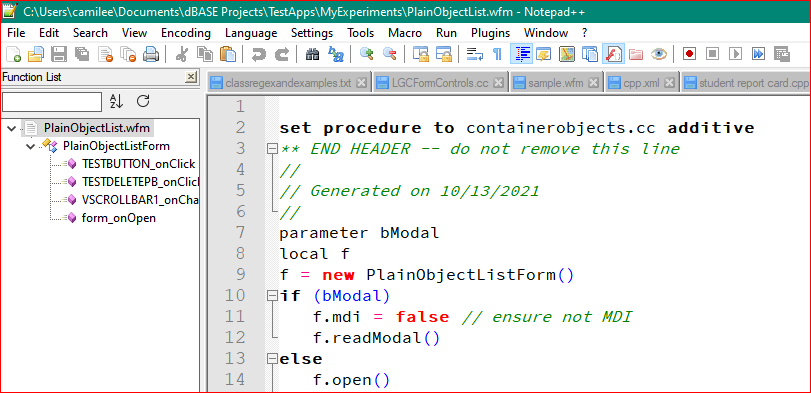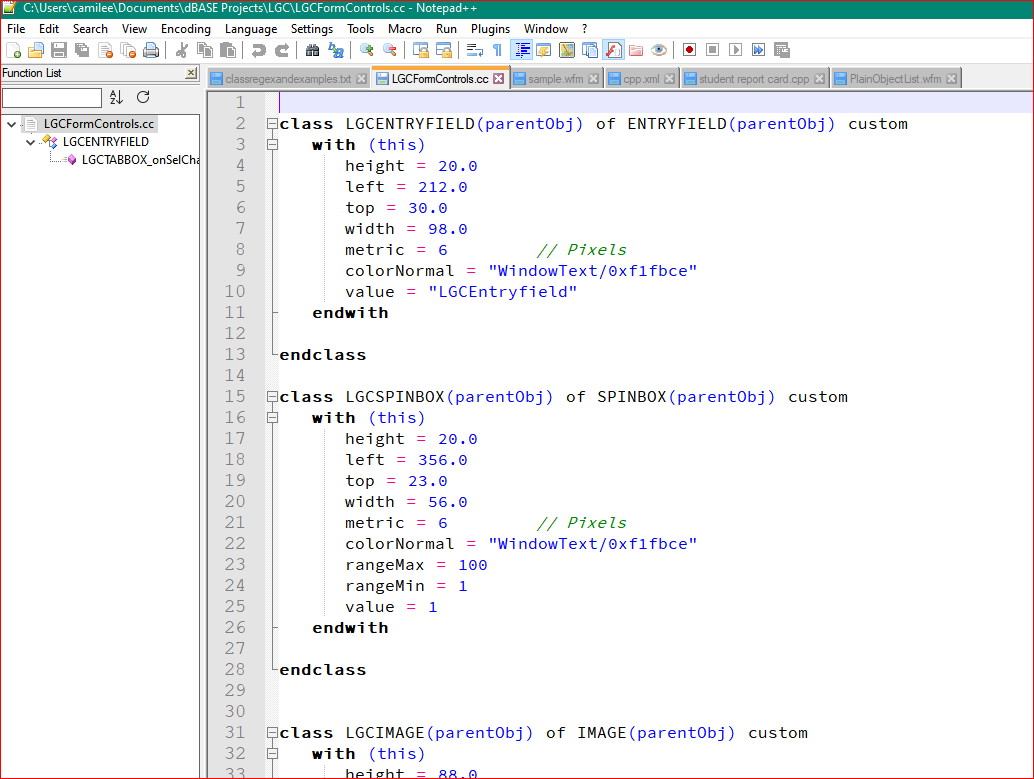FunctionList Confused
-
@Lycan-Thrope
@michael-vincent said in FunctionList Confused:I think I had an epiphany about how the regex fits into the FunctionList, and would appreciate an up or down on if the understanding is correct, bearing in mind, I’m just picking up regex, the boost flavor, and learning the NPP FunctionList functionality.
Have you read the user manual that explains basic Function List behavior?
Maybe this community post is a little more detailed than the user manual?
Cheers.
-
@lycan-thrope said in FunctionList Confused:
will have to be manually removed to run the regex’s
You have read the FAQ wrong.
the syntax
1. `^(class)\s([a-zA-Z0-9]+)\s([a-zA-Z0-9+]+)\s([a-zA-Z0-9+]+)`renders as
^(class)\s([a-zA-Z0-9]+)\s([a-zA-Z0-9+]+)\s([a-zA-Z0-9+]+)
which you can then just copy/paste the red text.
Please note that what you had,
1: ‘^(class)\s([a-zA-Z0-9]+)\s([a-zA-Z0-9+]+)\s([a-zA-Z0-9+]+)’is not the same as
1: `^(class)\s([a-zA-Z0-9]+)\s([a-zA-Z0-9+]+)\s([a-zA-Z0-9+]+)`which renders correctly as
1:^(class)\s([a-zA-Z0-9]+)\s([a-zA-Z0-9+]+)\s([a-zA-Z0-9+]+)The
`key (often called “backtick” or “grave”) is the one that on a standard US keyboard is the same key as~, but unshifted . You are typing the single-quote / apostrophe key'(which on a US keyboard, is the unshifted version of", the double quote). The single-quote in the forum is then being rendered as ‘smart single quotes’‘...’in your post.The Formatting Forum Posts gives you plenty of copies of the ` character, which you can copy/paste if you are unable to type the character on your keyboard.
-
@peterjones said in FunctionList Confused:
`
Peter, thanks for clarifying that for me. I just want to show you why I used that character, besides not realizing where the backtick key was. In this screenshot of your message to me, as well as in the documentation FAQ for posting, I highlighted the character to see if these old eyes could make out what it was, and as you see, the little pop up that “says” what it is, is mistaken. :) Thanks for fixing that for me. :) Screenshot of what I saw:
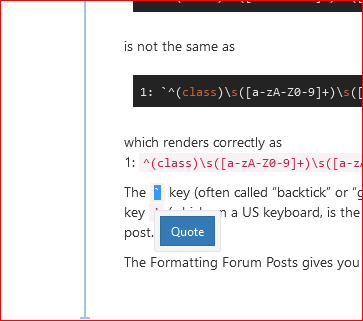
So really, thanks for clearing that up for me. :)
Lee
-
@lycan-thrope
So…let’s try this again, so I can see if it work right, with just the backtick.
7: (?:class)[\t\x20]*(?'Classname'\w+)([\t\x20]*?\(\w*(,[\t\x20]?\w*)*?\))?(([\t(\x20]of)[\t\x20](?'Superclass'\w*)(\(\w*(,[\t\x20]?\w*)*?\))?([\t\x20](?'Custom'custom))?([\t\x20]from[\t\x20](:\w*:\w*\.\w*|"\w*\.\w*"))?)?Woohoo…the preview shows it working, but as per the FAQ let’s see if it does it without all the backticking in side the regex on the multiline brackets. :)
Lee
-
@lycan-thrope One more time…with the whole thing. :)
These are the regexs I built leading up to the final ones (4,5,6,7) that work with the complete line in some or fashion. Still need to watch the word wrap.
1: ^(class)\s([a-zA-Z0-9]+)\s([a-zA-Z0-9+]+)\s([a-zA-Z0-9+]+)
2: ^(class)\s(\w*)\s(\w*)\s(\w*)
3: (?x)^[\t\x20]*(class)[\t\x20]+((\w+)|(\w+)[\x20]+(\((\w+)(,\w+)?\))?)?((\w+|[^\r\n]*)[\t\x20]+)*(custom)?
4: (class)[\t\x20]*(\w+)([\t\x20]*?\(\w*(,[\t\x20]?\w*)*?\))?([\t\x20]of[\t\x20]\w*(\(\w*(,[\t\x20]?\w*)*?\))?([\t\x20]custom)?([\t\x20]from[\t\x20](:\w*:\w*\.\w*|"\w*\.\w*"))?)?
5: (class)[\t\x20]*(\w+)([\t\x20]*?\(\w*(,[\t\x20]?\w*)*?\))?(([\t(\x20]of)[\t\x20]\w*(\(\w*(,[\t\x20]?\w*)*?\))?([\t\x20]custom)?([\t\x20]from[\t\x20](:\w*:\w*\.\w*|"\w*\.\w*"))?)?
6: (class)[\t\x20]*(\w+)([\t\x20]*?\(\w*(,[\t\x20]?\w*)*?\))?([\t(\x20]of[\t\x20](\w*))?(\(\w*(,[\t\x20]?\w*)*?\))?([\t\x20]custom)?([\t\x20]from[\t\x20]((:\w*:\w*\.\w*)|("\w*\.\w*")))?
7: (?:class)[\t\x20]*(?'Classname'\w+)([\t\x20]*?\(\w*(,[\t\x20]?\w*)*?\))?(([\t(\x20]of)[\t\x20](?'Superclass'\w*)(\(\w*(,[\t\x20]?\w*)*?\))?([\t\x20](?'Custom'custom))?([\t\x20]from[\t\x20](:\w*:\w*\.\w*|"\w*\.\w*"))?)? -
@lycan-thrope said in FunctionList Confused:
I highlighted the character to see if these old eyes could make out what it was, and as you see, the little pop up that “says” what it is, is mistaken.
The word “QUOTE” shows up like that if you select any text:

It is not telling you what character that is. It is the Forum asking you if you would like to use the selected text as the QUOTE portion in your reply.
If you have multiple lines of example text, use the LITERAL TEXT BOXES , not the RED TYPEWRITER TEXT.
But this is getting off the point, and you have shown your regexes. So unless you have more about FunctionList, I think we’ve spent enough on forum formatting.
-
@michael-vincent
Thanks Michael, that’s where some of the understanding is coming from, with the ability to read english via the Java.xml versus the cpp.xml, but since I’m not completely familar with java’s syntax and variations, it’s still clear as mud, but getting clearer. :-) -
@peterjones
I do appreciate your help, in this regard. I’ve been around awhile, but have to admit, posting in here, is a little different that what I’m used to, even after reading the FAQ…thanks for that clarification, though. Hate to look dumber than I am. :)Lee
-
@lycan-thrope
Okay, so no after beating the keyboard and my head all day, I figured it was time to present what I have tried and still doesn’t work…but to be fair, all I’m trying to do is get FunctionList to see my class first. Baby steps.This is my functionlist file:
<?xml version="1.0" encoding="UTF-8" ?> <!-- ==========================================================================\ | | To learn how to make your own language parser, please check the following | link: | https://npp-user-manual.org/docs/function-list/ | \=========================================================================== --> <NotepadPlus> <functionList> <!-- ========================================================= [ dBASEPlus ] --> <parser displayName="dBASEPlus" id ="dbaseplus" commentExpr="(?s:/\*.*?\*/)|(?m-s://.*?$)" > <classRange mainExpr="(?x) # use inline comments ^[\t\x20]* # leading whitespace class # class keyword [\t\x20]*(\w+) # class name # Following the class name there is the option of parameters, and if so # the first entry inside the parens is required, whether there is other # parameters or not, once the parens go up, the first is required. ie: # class FrameCtrl(frameObj) ([\t\x20]*?\(\w* # first and required parameter ((,[\t\x20]?\w*)*)?\))? # the following optional/additional parameters # For the rest of the class declaration, after the class name # all other options are part of one big optional set, that # follows 'of' and can be populated by one of several # options. The first and most prevalent is the Superclass # name that the class is being subclassed from, and it's # options of parameters and again, if it has parameters at # least the first one is required ie.: # class class ToolButtonFx(oParent) of Toolbutton(oParent) (([\t(\x20]of)[\t\x20]\w*(\(\w*((,[\t\x20]?\w*)*)?\))? # The next possible option is that it is a custom object and # needs to be in this line so if the object or form is opened # up in the dBASE IDE, the designers in it won't mess up # the object by streaming out missing parts or overriding # properties or objects and functions. ([\t\x20]custom)? # The next option is that the class is being subclassed from # another object that is contained elsewhere and the compiler # needs to know this reference. There are two options for # pointing to the file. The first is an Alias path in the IDE # that can be accessed by the compiler in the environment, or # second, it is in the current directory and only the name is # needed...or it has a path that can be listed here, but this # is bad practice, and an Alias is recommended if the file is in # a place other than the current directory. If it is, the name # can be used in quotes as a string that gets passed to the # compiler. Both follow the word 'From'. The Alias directory # is a name that is enclosed in two colons, one immediately # before the Alias name and one immediately after, no spaces. ([\t\x20]from[\t\x20](:\w*:\w*\.\w*| \x22 \w*\.\w* \x22))?)? # end of class declaration line " closeSymbole="endclass" > <className> <nameExpr expr="(?x) [\t\x20]*? ^class # class keyword [\t\x20]* \K(\w+) # Class name " /> </className> <function mainExpr=" # function body " > <functionName> <funcNameExpr expr=" # function parameters " /> <funcNameExpr expr=" " /> </functionName> </function> </classRange> <function mainExpr=" # function body " > <functionName> <nameExpr expr=" # function parameters " /> <nameExpr expr=" " /> </functionName> <className> <nameExpr expr=" " /> </className> </function> </parser> </functionList> </NotepadPlus>This is a basic file to be searched by the FunctionList dbaseplus.xml:
** END HEADER -- do not remove this line // // Generated on 10/13/2021 // parameter bModal local f f = new PlainObjectListForm() if (bModal) f.mdi = false // ensure not MDI f.readModal() else f.open() endif class PlainObjectListForm of FORM with (this) onOpen = class::FORM_ONOPEN doublebuffered = true metric = 6 // Pixels colorNormal = "Gray" height = 529.0 left = 110.0 top = 29.0 width = 1092.0 sizeable = false refreshAlways = false pageno = 0 endwith function form_onOpen() form.testcontainer.vscrollbar1.currentValue = ; form.testcontainer.vscrollbar1.value form.testContainer.aContainers = new array() form.testContainer.ncontainers = 0 form.testContainer.nSpacing = 2 return endclassI hope the fact that I don’t have a function search in it yet won’t be the problem, as all I want to do is verify I have the regex, the .xml file correct, and the settings and files in the right place. If it’s my regex and .xml, I won’t feel bad, as it’s new…what can I say, but I think I did it right. ::shrug::
Sorry if the .xml file is a bit long, but I copied it and emptied the C++ code figuring I was going to do this quick and left all the mixed parser stuff in it. ;-( Anyone see, off hand what I’m doing wrong or what’s wrong? I get no acknowledgement of even the file existence in the FunctionList head…that can’t be a good sign. :-(
Lee
-
Without any functions defined, the classes don’t show up in the list, even if they do match your text, so you aren’t going to be able to see it work without a function (even if it’s the simplest possible function).
If you want to individually test the regex, you can use the FIND or MARK dialogs with the same expression, which makes it easier to try variants.
If I try your class expression in the FIND dialog, it says that it’s an invalid expression.
When defining a new parser, I generally skip the
openSymboleandcloseSymboleexpressions, and just deal with themainExpr.Next, the way I do it, the
mainExprneeds to match all of the text in the class – so the wholeclass…endclass– not just the introductory line, because it only finds class-functions (ie, methods) if they exist inside. If I’m reading your expression right, it’s only matching the singleclassline. (Maybe with thecloseSymbole, you no longer needmainExprto match as much… but I wouldn’t trust that without more experimentation.)And when debugging, I try to make the main expression as simple as possible, especially at first; if it needs more complexity later on, I add it… but for helping you get something tot; when debugging it, I start with the simplest form. Which, I think for yours, would be "match from
classtoendclass. So I’d be tempted to start withmainExpr="(?xms) ^ \h* class \h+.* ^ \h* endclass"– when I use that in a FIND in your document, it finds fromclasstoendclassas I think I expect.Your class name expression looks reasonable, and does match the class name.
For simple testing, I would then define the function
mainExpr="(?x) \h* function \h+ (\w+)"But, as always, something goes wrong when I try things starting too complex. So I comment out the classRange, and just start with a simple function section:
<function mainExpr="(?x) \h* function \h+ (\w+)" > <functionName> <nameExpr expr="(?x) \h* function \h+ \K (\w+)" /> </functionName> </function>If I do that, and add a block before your class
function outsideAnything() here return(might not be valid, just using it for the parser), then reload when the
dbaseplus.xmlparser is properly linked in theoverrideMap.xml, and the existing file is associated with thedBASEPlusUDL, I get:

… so that means I am doing something right so far.But when I try to use that same
<function>block inside the<classRange>block, it won’t find the class (and no longer shows theform_onOpen)…Unfortunately, while I’m usually able to get it eventually, it takes time for me. And I’ve spent as much as I can on this for now. maybe I’ll have spare time later today to work on it. But, if nothing else, this will give you a good starting point, because with the classRange commented out as here, it finds two functions, which is at least a starting point for debug:
<?xml version="1.0" encoding="UTF-8" ?> <!-- ==========================================================================\ | | To learn how to make your own language parser, please check the following | link: | https://npp-user-manual.org/docs/function-list/ | \=========================================================================== --> <NotepadPlus> <functionList> <!-- ========================================================= [ dBASEPlus ] --> <parser displayName="dBASEPlus" id ="dbaseplus" commentExpr="(?s:/\*.*?\*/)|(?m-s://.*?$)" > <!--classRange mainExpr="(?xms) ^ \h* class \h+.* ^ \h* endclass" > <className> <nameExpr expr="(?x) [\t\x20]*? ^class [\t\x20]* \K(\w+)" /> </className> <function mainExpr="(?x) \h* function \h+ (\w+)" > <functionName> <nameExpr expr="(?x) \h* function \h+ \K (\w+)" /> </functionName> </function> </classRange--> <function mainExpr="(?x) \h* function \h+ (\w+)" > <functionName> <nameExpr expr="(?x) \h* function \h+ \K (\w+)" /> </functionName> </function> </parser> </functionList> </NotepadPlus>and
** END HEADER -- do not remove this line // // Generated on 10/13/2021 // parameter bModal local f f = new PlainObjectListForm() if (bModal) f.mdi = false // ensure not MDI f.readModal() else f.open() endif function outsideAnything() here return class PlainObjectListForm of FORM with (this) onOpen = class::FORM_ONOPEN doublebuffered = true metric = 6 // Pixels colorNormal = "Gray" height = 529.0 left = 110.0 top = 29.0 width = 1092.0 sizeable = false refreshAlways = false pageno = 0 endwith function form_onOpen() form.testcontainer.vscrollbar1.currentValue = ; form.testcontainer.vscrollbar1.value form.testContainer.aContainers = new array() form.testContainer.ncontainers = 0 form.testContainer.nSpacing = 2 return endclassSorry I couldn’t get more working yet…
-
@peterjones
Thank you very much, Peter. As I said, any help from another pair of eyeballs is appreciated, especially from someone who has done one before. At the least, you’ve confirmed some of what I wanted to know, that at least I might be getting the conceptualization of what to do to extract the names. I know that dBASE, as much as I like it, is somewhat of a loosely typed and ambiguously structured language, certainly nothing like C that I learned long ago, but it does still have stucture and trying to extrapolate from that to make it work in NPP is my problem to solve, I just wanted to know if I was doing something right or wandering in a far off land.Thanks for the tips and I’ll work on what you’ve provided to see if I can’t get a better result. I know I read in the FAQ about the Function issue, which is why I was hoping it wouldn’t be the stopping issue for this, but apparently, it might be the classrange/class/function combination that I neeed to work right since that is the area you point out. Thanks for getting it to provide something, so I have a start.
Lee
-
@lycan-thrope said in FunctionList Confused:
@peterjones
Thank you very much, Peter.Note I think there is an error in @PeterJones
functionNameblock in theclassRangetags. I think it should be :<functionName> <funcNameExpr expr="(?x) \h* function \h+ \K (\w+)" /> </functionName>Notice
funcNameExprinstead of justnameExpr.Cheers.
-
@michael-vincent said in FunctionList Confused:
Note I think there is an error in @PeterJones
functionNameblock in theclassRangetags.And when I fix that, I now see the function in the class.
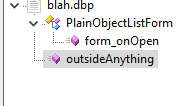
So @Lycan-Thrope , that’s what you need to fix, and my simple mixed parser now works with your example code.
<?xml version="1.0" encoding="UTF-8" ?> <!-- ==========================================================================\ | | To learn how to make your own language parser, please check the following | link: | https://npp-user-manual.org/docs/function-list/ | \=========================================================================== --> <NotepadPlus> <functionList> <!-- ========================================================= [ dBASEPlus ] --> <parser displayName="dBASEPlus" id ="dbaseplus" commentExpr="(?s:/\*.*?\*/)|(?m-s://.*?$)" > <classRange mainExpr="(?xms) ^ \h* class \h+.* ^ \h* endclass" > <className> <nameExpr expr="(?x) [\t\x20]*? ^class [\t\x20]* \K(\w+)" /> </className> <function mainExpr="(?x) \h* function \h+ (\w+)" > <functionName> <funcNameExpr expr="(?x) \h* function \h+ \K (\w+)" /> </functionName> </function> </classRange> <function mainExpr="(?x) \h* function \h+ (\w+)" > <functionName> <nameExpr expr="(?x) \h* function \h+ \K (\w+)" /> </functionName> </function> </parser> </functionList> </NotepadPlus>(Since I used the
(?x), you can go back and add newlines and comments to document the regex again; I just collapsed them because it’s easier to copy/paste into FIND dialog that way) -
@michael-vincent
Thank you Michael for that catch. I wouldn’t have seen that while following instructions. :-)Lee
-
@peterjones
Thank you so much also Peter. I can now feel somewhat elated at banging my head all day yesterday. :-)Now to get back to work…had to take sometime for house chores since I neglected them yesterday beating my head on the keyboard. :-)
Lee
-
@lycan-thrope
Argh…sigh…I must be setup wrong or something. I just tried it with it in both the Appdata directory NPP FunctionList directory and the Program(x86) FunctionList directory and it’s not showing anything…so back to reading the docs, since I know yours works. :-( -
Can you show the relevant portion of
overrideMap.xml, and compare that to the name in the User Defined Language list / definition?in my working version (which is a portable, so no %AppData%):
<!-- ==================== User Defined Languages ============================ --> <association id= "krl.xml" userDefinedLangName="KRL"/> <association id= "sinumerik.xml" userDefinedLangName="Sinumerik"/> <association id= "universe_basic.xml" userDefinedLangName="UniVerse BASIC"/> <association id= "dbaseplus.xml" userDefinedLangName="dBASEPlus"/> <!-- ======================================================================== -->and from the UDL definition:
<UserLang name="dBASEPlus" ext="dbp" udlVersion="2.1">Notice that the
userDefinedLangNamein overrideMap andnamein UDL definition match exactly.And the active file must have selected the
dBASEPlusUDL as its syntax highlighter – either through automatic extension (.dbpin my example), or by manually selecting Language > dBASEPlus, where the dBASEPlus will be down below the User Defined Language… submenu: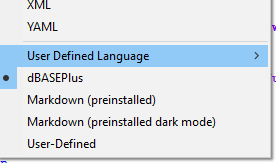
Also remember that for any change in functionList settings to take effect, you have to completely exit Notepad++ and restart it.
-
@lycan-thrope
Well, kind of at a loss to explain this. I’ve gone over the installations again, made sure the Appdata directories had the right files, even went into Admin mode to make sure it wasn’t rejected. The folowing screenshot shows the overrideMap.xml at the end where the UDL association is stored.

Mind you, this was while I only had the UDL in the dialog box, not stored in the UDL folder in AppData area.When I thought, hmm…maybe the file needs to be in the UDL Appdata folder I took an exported version I’ve made, renamed it appropriately “dBASEPlus.xml” and now I have this:
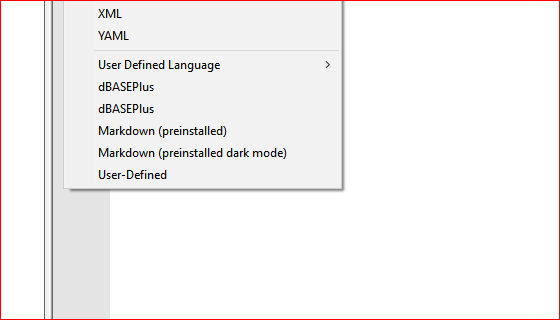
I wasn’t able to get it to work without the duplicate there or not. I’m going to delete the UDL file contents to see if that does the trick, either way, all the file extension needed were listed in that UDL and the pasted and copied version of Peter’s code still wasn’t working, so it must be me. :-(
File extensions in UDL file:

I guess I’ll need to retrace my steps.
Lee
-
@lycan-thrope
Smacking self vigorously about the face and head. :-(I’m glad I was re-reading out posts, and noticed that I had NOT exactly put the right name in the associations I had spelled it “dBasePlus” in the non-working file and after changing it to the proper “dBASEPlus”, it worked on reboot…so thank you very much Peter for saving me from myself. Maybe now I can get to some productive work of finishing this UDL for use for the community and of course, if it’s of use to this NPP community, it’s of course usable…just need to check how to add it to the UDL’s. Of course, I need to make sure the rest of the keywords are put in, don’t collide with each other and other delimiters etc…and make sure I can fully flesh out as much as I can without having to actually write a lexer for the language, because…let’s face, I don’t think I’m qualified for that extensive bit of work. :-)
Lee
-
@lycan-thrope
Next hurdle, I need to addess and ask about. Does the parser only handle one class and multiple functions per file? Or does it require for a class to be listed that it has a function in it?I tried using my original code with some of Peter’s and found it messing up on the class not showing up, and the functions acting a little erratic. I’ve put it back to the way he wrote it now, with one or two changes that don’t seem to affect the end result, but I’m checking the different kinds of files we use, and one in particular, our .cc file which usually are Custom Component files include more than one class.
In the one I was testing of my own creation, of the multiple classes I have in it, only one of them has a function, and it was the only one that showed up in FunctionList panel, which is what prompted this question coming up. If I just need to work further to get it to function listing classes, that is one thing, but if it’s not built to that, I wanted to check, as I don’t seem to have any multiple class code files available right now for any of the languages available in NPP…I will but just don’t have them right now…and it’s getting late time to stop beating the keyboard. :) Thanks in advance.
Here’s two screenshots of the one class, multiple functions and one of the multiple classes but one function in the FunctionList panel.
Lee
